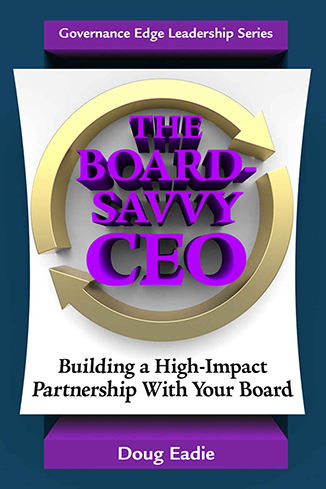 Several posts at this blog have described what I call “insidious foes” of a solid board-CEO working relationship. These are erroneous assumptions about the nature of the governing function that can cause real damage. What makes them insidious is that they can – at least at first blush – sound quite plausible. A classic example is the assumption that small boards are more effective than larger ones, which has led many CEOs to convince their boards to slide down the slippery slope of downsizing, modestly increasing the board’s “efficiency” at the expense of diversity – in terms of experience, expertise, perspectives, connections with the wider world, access to resources, etc. What a high price to pay for such a minor benefit! Another insidious foe I have frequently encountered is the assumption that what we call “letterhead” board members are an indispensable part of a governing board’s composition. We took a close look at this dangerous erroneous assumption at the board-CEO relationship building workshop I conducted a couple of years ago at the International Economic Development Council Leadership Summit in Las Vegas.
Several posts at this blog have described what I call “insidious foes” of a solid board-CEO working relationship. These are erroneous assumptions about the nature of the governing function that can cause real damage. What makes them insidious is that they can – at least at first blush – sound quite plausible. A classic example is the assumption that small boards are more effective than larger ones, which has led many CEOs to convince their boards to slide down the slippery slope of downsizing, modestly increasing the board’s “efficiency” at the expense of diversity – in terms of experience, expertise, perspectives, connections with the wider world, access to resources, etc. What a high price to pay for such a minor benefit! Another insidious foe I have frequently encountered is the assumption that what we call “letterhead” board members are an indispensable part of a governing board’s composition. We took a close look at this dangerous erroneous assumption at the board-CEO relationship building workshop I conducted a couple of years ago at the International Economic Development Council Leadership Summit in Las Vegas.
A letterhead board member, as my readers well know, is a board member in name only – part of a special caste of board members who are not expected to engage in the demanding nuts and bolts work of governing, such as attending full board and committee meetings. A letterhead board member is typically the CEO of an important stakeholder organization whose support is seen as critical to a nonprofit’s success. These CEOs are invariably primo influencers whose word carries tremendous weight in the nonprofit’s environment. And, of course, they are often so busy serving on other boards that they will join yours only in name.
This doesn’t mean they can’t add value, typically in the form of ad hoc assistance at the CEO’s request (picking up the phone to solicit funding for a special event; convincing a leader to accept an invitation to join your board; being part of a concerted effort to sell a firm on re-locating to your community, etc.). But are they indispensable governing board members? Hardly, and experience has taught me that they are quite likely to damage the board-CEO working relationship by fostering frustration, aggravation, and dissatisfaction among board members who are active participants in the governing process. Every board-savvy CEO knows that aggravated board members nursing grievances make for less committed and reliable partners.
As I’ve learned from hundreds of interviews with board members in preparing for retreats, the board members who are not exempt from the nuts and bolts work of governing tend to deeply resent being treated like “worker bees” who don’t loom large enough to merit letterhead status. And maintaining a two-tier system of privileged, non-working board members and lower-caste board members expected to work in the governing trenches over time erodes a board’s performance, which fosters dissatisfaction. After all, if I’m not part of the privileged, non-working elite, why wouldn’t I resist committing to specific governing performance targets and having my governing performance evaluated by the governance or executive committee of the board?
My take on why this particular insidious foe continues to raise its ugly head? Very simply, many CEOs think that the only way they can capitalize on the heavy-hitter CEOs who are unwilling or unable to do the detailed work of governing is by rewarding them with board seats that come with no governing responsibilities. This is absolutely not true! In the IEDC board-CEO partnership workshop I mentioned early, we discussed practical ways to capitalize on these heavy-hitters by engaging them in high-level non-board/non-governing bodies requiring far less time than serving on the governing board. For example, one that has proved very effective in practice is a blue ribbon “strategic advisory council” that meets only once a year for the purpose of assessing environmental conditions and trends and identifying looming issues (challenges and opportunities). This high-level brainstorming can easily be fed into the governing board’s annual strategic planning retreat, and might even be presented by representatives of the strategic advisory council.
By the way, over the years I’ve come across only a handful of CEOs who find being a letterhead board member an honor. By their very nature, these leaders aspire to make a difference, and if they don’t have time to serve on a governing board, they are typically very open to other vehicles for meaningful, high-impact engagement.





